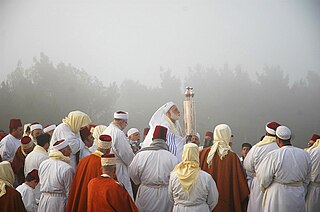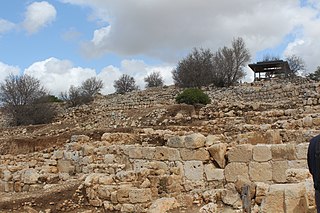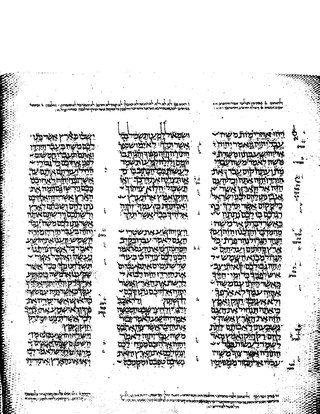
Ezra or Esdras, also called Ezra the Scribe in Chazalic literature and Ezra the Priest, was an important Jewish scribe (sofer) and priest (kohen) in the early Second Temple period. In Greco-Latin Ezra is called Esdras. His name is probably a shortened Aramaic translation of the Hebrew name עזריהו Azaryahu, "Yah helps". In the Greek Septuagint the name is rendered Ésdrās, from which the Latin name Esdras comes.

The Samaritans, or the Samaritan people, are an ethnoreligious group originating from the Hebrews and Israelites of the ancient Near East. They are indigenous to Samaria, a historical region of ancient Israel and Judah that comprises the northern half of today's West Bank. They are naturally adherents of Samaritanism, an Abrahamic, monotheistic, and ethnic religion that developed alongside Judaism.

The Samaritan Pentateuch, also called the Samaritan Torah, is the sacred scripture of the Samaritans. Written in the Samaritan script, it dates back to one of the ancient versions of the Torah that existed during the Second Temple period, and constitutes the entire biblical canon in Samaritanism.

The Aleppo Codex is a medieval bound manuscript of the Hebrew Bible. The codex was written in the city of Tiberias in the tenth century CE under the rule of the Abbasid Caliphate, and was endorsed for its accuracy by Maimonides. Together with the Leningrad Codex, it contains the Aaron ben Moses ben Asher Masoretic Text tradition.

Shiloh was an ancient city and sanctuary in Samaria. According to the Hebrew Bible, Shiloh was one of the main centers of Israelite worship during the pre-monarchic period, before the First Temple in Jerusalem was built. After the Israelite conquest of Canaan, the Tabernacle was moved to Shiloh, and remained there during the period of the biblical judges.

Gibeah is the name of three places mentioned in the Hebrew Bible, in the tribes of Benjamin, Judah, and Ephraim respectively.

Eleazar or Elazar was a priest in the Hebrew Bible, the second High Priest, succeeding his father Aaron after he died. He was a nephew of Moses.
Zadok or Zadok HaKohen, also spelled Ṣadok, Ṣadoc, Zadoq, Tzadok or Tsadoq, was a Kohen (priest), biblically recorded to be a descendant from Eleazar the son of Aaron. He was the High Priest of Israel during the reigns of David and Solomon. He aided King David during the revolt of his son Absalom, was subsequently instrumental in bringing Solomon to the throne and officiated at Solomon's coronation. After Solomon's building of the First Temple in Jerusalem, Zadok was the first High Priest to serve there.
The Paleo-Hebrew script, also Palaeo-Hebrew, Proto-Hebrew or Old Hebrew, is the writing system found in inscriptions of Canaanite languages from the region of Southern Canaan, also known as biblical Israel and Judah. It is considered to be the script used to record the original texts of the Hebrew Bible due to its similarity to the Samaritan script, as the Talmud stated that the Hebrew ancient script was still used by the Samaritans. The Talmud described it as the "Libona'a script", translated by some as "Lebanon script". Use of the term "Paleo-Hebrew alphabet" is due to a 1954 suggestion by Solomon Birnbaum, who argued that "[t]o apply the term Phoenician [from Northern Canaan, today's Lebanon] to the script of the Hebrews [from Southern Canaan, today's Israel-Palestine] is hardly suitable". The Paleo-Hebrew and Phoenician alphabets are two slight regional variants of the same script.
In the Torah, Ithamar was the fourth son of Aaron the High Priest. Following the construction of the Tabernacle, he was responsible for recording an inventory to ensure that the constructed Tabernacle and its contents conformed to the vision given by God to Moses on Mount Sinai.

Joseph's Tomb is a funerary monument located in Balata village at the eastern entrance to the valley that separates Mounts Gerizim and Ebal, 300 metres northwest of Jacob's Well, on the outskirts of the West Bank city of Nablus. It has been venerated throughout the ages by Samaritans, for whom it is the second holiest site; by Jews; by Christians; and by Muslims, some of whom view it as the location of a local sheikh, Yusef al-Dwaik or Dawiqat, who died in the 18th century.

According to the Hebrew Bible, Phinehas or Phineas was a priest during the Israelites' Exodus journey. The grandson of Aaron and son of Eleazar, the High Priests, he distinguished himself as a youth at Shittim with his zeal against the heresy of Peor.
Malchijah is a biblical name belonging to several persons mentioned in the Hebrew Bible and means "Yahweh is King" or "the king is Yahweh".

David's Tomb is a site that, according to an early-medieval (9th-century) tradition, is associated with the burial of the biblical King David. Historians, archaeologists and Jewish religious authorities do not consider the site to be the actual resting place of King David. It occupies the ground floor of a former church, whose upper floor holds the Cenacle or "Upper Room" traditionally identified as the place of Jesus' Last Supper and the original meeting place of the early Christian community of Jerusalem.

Awarta is a Palestinian town located 8 kilometers (5.0 mi) southeast of Nablus, in the northern West Bank. According to the Palestinian Central Bureau of Statistics, the town had a population of 7,054 inhabitants in 2017. Awarta's built-up area consists of 540 dunams and it is governed by a village council.

The Tomb of Aaron is the name of the supposed burial place of Aaron, the brother of Moses, according to Jewish, Christian, and local Muslim tradition.

The Samaritan High Priest is the high priest of the Samaritan community in the Levant. According to Samaritan tradition, the office has existed continuously since the time of Aaron, the brother of Moses, and has been held by 133 priests over the last 3400 years. However, the historicity of this claim is disputed. One account by Josephus suggests that its office holders are an offshoot of the Zadokite high priests of Jerusalem from around the time of Alexander the Great. As of 2013, the incumbent high priest is Abdel V.

The Tomb of Joshua, i.e. the burial site of the biblical figure Joshua, and that of his companion Caleb are, according to a Samaritan tradition noted in 1877, at Kifl Haris in the West Bank. Religious Jews also identify one of the mausolea at Kifl Haris with that of Joshua and thousands of them go there on pilgrimage on the annual commemoration of his death, 26th of Nisan on the Hebrew calendar.

Joshua 24 is the twenty-fourth chapter of the Book of Joshua in the Hebrew Bible or in the Old Testament of the Christian Bible. According to Jewish tradition the book was attributed to the Joshua, with additions by the high priests Eleazar and Phinehas, but modern scholars view it as part of the Deuteronomistic History, which spans the books of Deuteronomy to 2 Kings, attributed to nationalistic and devotedly Yahwistic writers during the time of the reformer Judean king Josiah in 7th century BCE. This chapter records Joshua's final address to the people of Israel, that ends with a renewal of the covenant with YHWH, and the appendices of the book, a part of a section comprising Joshua 22:1–24:33 about the Israelites preparing for life in the land of Canaan.

















